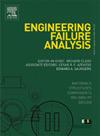Crack suppression and ductility modification of additive manufactured Ti6Al4V/W heterostructure interface via Nano-TiC reinforcement
IF 5.7
2区 工程技术
Q1 ENGINEERING, MECHANICAL
引用次数: 0
Abstract
The incorporation of titanium alloy Ti-6Al-4 V (TC4) and tungsten (W) into hybrid structures presents considerable potential for utilization in extreme environments. However, challenges such as interfacial brittleness, residual stresses, and limited metallurgical compatibility impede effective bonding. In this study, laser powder bed fusion (L-PBF) was employed to fabricate TC4/W bimetallic heterostructures, with nano-TiC particles introduced at the interface to improve interfacial bonding and mechanical performance. Experimental findings indicate that the addition of nano-TiC effectively reduces interfacial defects, refines grain structure by decreasing the average grain size by 16.7–27.5 %, and facilitates the formation of β-Ti/W infinite solid solutions with fully coherent interfaces. These microstructural enhancements lead to significant improvements in mechanical properties, as evidenced by an increase in ultimate tensile strength (UTS) from 600 MPa to 725 MPa and an improvement in elongation (EL) from 6.8 % to 10.3 %. The observed strengthening mechanisms primarily result from grain boundary refinement, dislocation pinning, and Orowan strengthening effects. The findings of this study present a feasible approach for optimizing additive-manufactured TC4/W composites to meet the stringent demands of aerospace and nuclear applications.
纳米tic增强添加剂制备Ti6Al4V/W异质结构界面的裂纹抑制和延性改性
将钛合金ti - 6al - 4v (TC4)和钨(W)结合到混合结构中,在极端环境中具有相当大的应用潜力。然而,界面脆性、残余应力和有限的冶金相容性等挑战阻碍了有效的结合。在本研究中,采用激光粉末床熔合(L-PBF)制备TC4/W双金属异质结构,在界面处引入纳米tic颗粒以改善界面结合和力学性能。实验结果表明,纳米tic的加入有效地减少了界面缺陷,细化了晶粒结构,平均晶粒尺寸减小了16.7% ~ 27.5%,有利于形成界面完全共融的β-Ti/W无限固溶体。这些微观组织的增强导致了机械性能的显著改善,如极限抗拉强度(UTS)从600 MPa增加到725 MPa,伸长率(EL)从6.8%提高到10.3%。观察到的强化机制主要是晶界细化、位错钉住和Orowan强化效应。本研究结果为优化增材制造TC4/W复合材料提供了一种可行的方法,以满足航空航天和核应用的严格要求。
本文章由计算机程序翻译,如有差异,请以英文原文为准。
求助全文
约1分钟内获得全文
求助全文
来源期刊

Engineering Failure Analysis
工程技术-材料科学:表征与测试
CiteScore
7.70
自引率
20.00%
发文量
956
审稿时长
47 days
期刊介绍:
Engineering Failure Analysis publishes research papers describing the analysis of engineering failures and related studies.
Papers relating to the structure, properties and behaviour of engineering materials are encouraged, particularly those which also involve the detailed application of materials parameters to problems in engineering structures, components and design. In addition to the area of materials engineering, the interacting fields of mechanical, manufacturing, aeronautical, civil, chemical, corrosion and design engineering are considered relevant. Activity should be directed at analysing engineering failures and carrying out research to help reduce the incidences of failures and to extend the operating horizons of engineering materials.
Emphasis is placed on the mechanical properties of materials and their behaviour when influenced by structure, process and environment. Metallic, polymeric, ceramic and natural materials are all included and the application of these materials to real engineering situations should be emphasised. The use of a case-study based approach is also encouraged.
Engineering Failure Analysis provides essential reference material and critical feedback into the design process thereby contributing to the prevention of engineering failures in the future. All submissions will be subject to peer review from leading experts in the field.
 求助内容:
求助内容: 应助结果提醒方式:
应助结果提醒方式:


